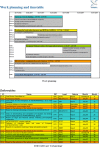History of Astroparticle Physics and its Components
- PMID: 28163605
- PMCID: PMC5253798
- DOI: 10.12942/lrr-2008-2
History of Astroparticle Physics and its Components
Abstract
This article gives an outline of the historical events that led to the formation of contemporary astroparticle physics. As a starting point for analyzing the history of astroparticle physics this article will review the various, yet scattered pieces of historical work that have been done so far. To make the picture more complete it will then give a brief survey of the most important fields that have played a role in the development of astroparticle physics as we know it today. It will conclude with an overview of the historical questions that are still open and the rich philosophical implications that lie behind those questions.
Electronic supplementary material: Supplementary material is available for this article at 10.12942/lrr-2008-2.
Figures












Similar articles
-
Non-empirical physics from a historical perspective: New pathways in history and philosophy of physics.Stud Hist Philos Sci. 2025 Apr;110:13-16. doi: 10.1016/j.shpsa.2025.01.004. Epub 2025 Feb 12. Stud Hist Philos Sci. 2025. PMID: 39946837
-
Astroparticle physics and cosmology.Lancet. 2006 May 20;367(9523):1692-7. doi: 10.1016/S0140-6736(06)68738-2. Lancet. 2006. PMID: 16714191 Review.
-
Astroparticle physics with solar neutrinos.Proc Jpn Acad Ser B Phys Biol Sci. 2011;87(5):215-29. doi: 10.2183/pjab.87.215. Proc Jpn Acad Ser B Phys Biol Sci. 2011. PMID: 21558758 Free PMC article. Review.
-
From the History of the Croatian Dermatovenereological Society - The Croatian Medical Association and an Overview of Important Information Regarding the Journal Acta Dermatovenerologica Croatica.Acta Dermatovenerol Croat. 2018 Dec;26(4):344-348. Acta Dermatovenerol Croat. 2018. PMID: 30665489
-
Combatting cancer in the third millennium--the contribution of medical physics.Phys Med. 2008 Jun;24(2):42-8. doi: 10.1016/j.ejmp.2008.01.002. Epub 2008 Mar 4. Phys Med. 2008. PMID: 18295523
Cited by
-
The evolution of knowledge within and across fields in modern physics.Sci Rep. 2020 Jul 21;10(1):12097. doi: 10.1038/s41598-020-68774-w. Sci Rep. 2020. PMID: 32694516 Free PMC article.
References
-
- Alexander T. Stars and singularities: stellar phenomena near a massive black hole. In: Falcke H, Hehl FW, editors. The Galactic Black Hole: Lectures on General Relativity and Astrophysics. Bristol, U.K.; Philadelphia, U.S.A.: IOP Publishing; 2003. pp. 246–274.
-
- Anderson CD. Unravelling the Particle Content of the Cosmic Rays. In: Sekido Y, Elliot H, editors. Early History of Cosmic Ray Studies: Personal Reminiscences with Old Photographs. Dordrecht, Netherlands; Boston, U.S.A.: D. Reidel; 1985. p. 117.
-
- Anon., “New radio waves traced to centre of the Milky Way”, New York Times, (May 5, 1933).
-
- APOD/NASA, “Centaurus A: The Galaxy Deep Inside”, image. URL (cited on 28 February 2007): http://antwrp.gsfc.nasa.gov/apod/ap981204.html.
Publication types
LinkOut - more resources
Full Text Sources
Research Materials
